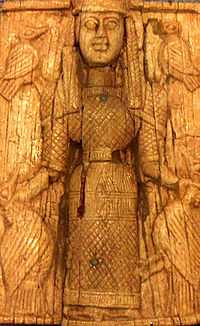Potnia


Potnia is an Ancient Greek word for "Mistress, Lady" and a title of a goddess. The word was inherited by Classical Greek from Mycenean Greek with the same meaning and it was applied to several goddesses. A similar word is the title Despoina, "the mistress", which was given to the nameless chthonian goddess of the mysteries of Arcadian cult. She was later conflated with Kore (Persephone), "the maid", the goddess of the Eleusinian mysteries,[1] in a life-death rebirth cycle which lead the neophyte from death into life and immortality. Karl Kerenyi identifies Kore with the nameless "Mistress of the labyrinth", who probably presided over the palace of Knossos in Minoan Crete.
Etymology
Potnia (Greek: πότνια, "mistress")[2] is a poetic title of honour, used chiefly in addressing females, whether goddesses or women; its masculine analogue is posis (πόσις).[3] Its hypothetical PIE form *pot-niha-, "mistress", "lady", "wife", is the feminine counterpart to *pótis, "husband"; cf. Latin hospēs, "host", Sanskrit páti-, "master", "husband", fem. pátnī-, "lady", "wife".[4] Potnia is attested in the Linear B script in Mycenean Greek: 𐀡𐀴𐀛𐀊 po-ti-ni-ja. The word was inherited in classical Greek with the same meaning. A relative Greek word to it is despoina ("Des-potnia" from PIE *dems-potnia meaning "mistress of the house").[5]
Origins
The figure of a goddess of nature, of birth and death was dominant during the Bronze Age, both in Minoan and Mycenean cult. In Mycenean cult she was known under the title Potnia.[6] The earliest reference to the term are inscriptions in Linear B (Mycenean Greek) syllabic script found in Pylos and Knossos of Crete dated 1450-1300 BC. On a number of tablets from Pylos, we find po-ti-ni-ja (potnia) without any accompanying word. Chadwick suggests that she was the mother-goddess of the Mycenaeans. It seems that she had an important shrine at the site Pakijanes near Pylos.[7] Wanax (wa-na-ka) was her male companion in Mycenean cult,[6] and this title was usually applied to the god Poseidon (po-se-da-o) as king of the underworld. Another epithet of Poseidon was e-ne-si-da-o-ne ("earth-shaker") and in the cave of Amnisos (Crete) Enesidaon is related with the cult of Eileithyia.[8] She was a goddess of nature concerned with the annual birth of the divine child.[9] Potnia and her male companion (paredros) survived in the Eleusinian cult, where the following words were uttered : "Mighty Potnia has born a strong son".[10]
An inscription from Knossos is referring to the "potnia of the labyrinth" (Mistress of the Labyrinth), who probably presided over the palace of Knossos (da-pu2-ri-to-jo,po-ti-ni-ja).[11][12] A famous Minoan seal impression found by Arthur Evans shows a nameless goddess brandishing a spear and standing upon the representation of a mountain flanked by rampant lions, and the representation seems similar with the Homeric potnia theron (the mistress of the animals).
Several tablets in Linear B script found at Knossos and Pylos refer to the potnia (mistress). Potnia is almost always accompanied by an epithet characterizing a particular place or function of the mistress : po-ti-ni-ja,a-si-wi-ja (a-si-wi-ja = ethnic adjective, possibly "Asian (Lydian) woman"), si-to-po-ti-ni-ja (sitos = "grain", of wheat or barley; probably referring to Demeter or her predecessor), po-ti-ni-ja,i-qe-ja (Potnia Hippeia, "Horse Goddess"). At Knossos a tablet is referring to a-ta-na-po-ti-ni-ja, "potnia Athana", a form similar to the later Homeric form.[7][13]
Classical Greece
In classical Greece the title potnia is usually applied to the goddesses Demeter, Artemis, Athena, and Persephone. This title was also given to the earth goddess Gaia (Ge). A similar title Despoina, "the mistress", was given to the nameless goddess of the mysteries of Arcadian cult, later conflated with Kore (Persephone), the goddess of the Eleusinian mysteries. Homer in Iliad (xxi 470) mentions a potnia theron (mistress of the animals) who is obviously Artemis. Karl Kerenyi identifies Persephone with the nameless "mistress of the labyrinth" (potnia of labyrinth).Demeter and Persephone were the two Great goddesses of the Arcadian cults. According to Pausanias at Olympia they were called Despoinai ("mistresses", plural of Despoina).[14] Demeter and Persephone were also called "Demeteres" as duplicates of the earth goddess with a double function as chthonic and vegetation goddesses.
See also
- Despoina
- Persephone
- Potnia theron
- List of Mycenaean deities
References
- ↑ Princeton Encyclopedia of classical sites
- ↑ πότνια. Liddell, Henry George; Scott, Robert; A Greek–English Lexicon at the Perseus Project.
- ↑ πόσις in Liddell and Scott.
- ↑ J. P. Mallory, J. P.; Adams, D. Q. (2006). The Oxford Introduction to Proto-Indo-European and the Proto-Indo-European World. Oxford University Press. pp. 207, 505.
- ↑ Harper, Douglas. "despot". Online Etymology Dictionary.
- ↑ 6.0 6.1 B.Dietriech (2004):The origins of the Greek religion Bristol Phoenix Press.pp. 181-185
- ↑ 7.0 7.1 G.Mylonas (1965) Mycenae and the Mycenaean age Princeton University Press, p.159
- ↑ Dietriech, p.181
- ↑ Dietrich: pp.109,141
- ↑ Dietrich:166-167
- ↑ Kn Gg 702:da-pu2ri-to-jo po-ti-ni-ja
- ↑ Ventris M. and Chadwick J. Documents in Mycenean Greek 1976. Cambridge UP. ISBN 0-521-08558-6
- ↑ Chadwick J.The Mycenean world.1976.Cambridge UP. ISBN 0-521-29037-6
- ↑ Pausanias.Description of Greece.